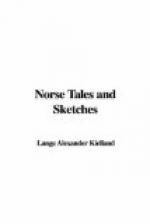If from any cause a disturbance arises, it is soon arranged upon this principle; and when the geese have flown a day or two from the starting-point, such rearrangement is doubtless effected more rapidly and more easily. For I am convinced that they soon come to know one another personally so well that each at once finds his comrade in flight, whom he is accustomed to have before his eye, and therefore they are able to take their fixed places in the ranks as surely and accurately as trained soldiers.
We can all the more readily imagine such a personal acquaintance among animals, as we know that even men learn with comparative ease to distinguish individuals in flocks of the same species of beasts. If we townspeople see a flock of sheep, it presents to us the same ovine face—only with some difference between old and young. But a peasant-woman can at once take out her two or three ewes from the big flock that stands staring by the door—indeed, she can even recognise very young lambs by their faces.
Thus I believe I understand the reason for the wild-goose’s order of flight better than when I thought of a plough that ‘clove’ the air; and, as already stated, it may well be that many have been just as wise long ago. But I venture to wager that the great majority of people have never thought of the matter at all, and I fear that multitudes will think of it somewhat in this fashion: ’What is it to me how those silly geese fly?’
I often revert to the strangely thoughtless manner in which knowledge of animal life is skipped over in the teaching of the young. The rude and wild conception of animals which the clergy teach from the Old Testament seems to cause only deep indifference on the part of the girls, and, in the boys, an unholy desire to ramble about and blaze away with a gun.
Here there has been a shooting as on a drill-ground all the summer, until now only the necessary domestic animals are left. Among the cows, the starlings were shot into tatters, so that they crawled wingless, legless, maimed, into holes in the stone fences to die. If a respectable curlew sat by the water’s edge mirroring his long bill, a rascal of a hunter lay behind a stone and sighted; and was there a water-puddle with rushes that could conceal a young duck, there immediately came a fully-armed hero with raised gun. Even English have been here! They had some new kind of guns—people said—that shot as far as you pleased, and round corners and behind knolls. They murdered, I assure you; they laid the district bare as pest and pox! I must stop, for I am growing so angry.
I have had thoughts of applying for a post as inspector of birds in the Westland. I should travel round and teach people about the birds, exhibit the common ones, so that all might have the pleasure of recognising them in Nature; accustom people to listen to their song and cry, and to take an interest in their life, their nests, eggs, and young.




